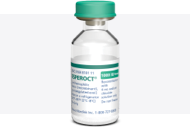Indicated for use in adults and children with hemophilia A for on-demand treatment and control of bleeding episodes, perioperative management of bleeding, and routine prophylaxis to reduce the frequency of bleeding episodes. Esperoct® is not indicated for the treatment of von Willebrand disease.

Actor portrayal
aPrior to reconstitution, Esperoct® can be stored from 36 °F to 46 °F for up to 30 months, at room temperature up to 86 °F for up to 12 months, or up to 104 °F for up to 3 months.1 See Prescribing Information for complete product storage information.
bPrior to reconstitution, Esperoct® can be stored from 36 °F to 46 °F for up to 30 months, at room temperature up to 86 °F for up to 12 months, or up to 104 °F for up to 3 months.1 See Prescribing Information for complete product storage information.
cBased on bleeding episodes. See Prescribing Information for complete dosing instruction.
dMedian annualized bleeding rate (ABR) from the main phase (1.2) and the main and extension phases (0.8) of the pivotal clinical trials in previously treated patients (PTPs) aged ≥12 years old (n=177) with severe hemophilia A who received Esperoct® 50 IU/kg every 4 days for up to 6.6 years.
eMedian ABR of 0.8 from the main and extension phases of previously treated children aged <12 years old (n=68) who took Esperoct® 60 IU/kg (range 50-75 IU/kg) twice weekly for up to 5.4 years.
PPx= prophylaxis
A proven safety profile with long-term data1
Research shows 0 thrombotic events across 5 clinical trials.1 Learn more about our long-term data and the latest recommendations for treating your patients.
High trough levels for a broad range of patients1
Esperoct® has a longer half-life compared to SHL FVIII products. Trough levels stabilized in the range of mild/moderate hemophilia,~5%, for a majority of the time in adults and adolescents.9,10,c
Tammy has
hemophilia A
and uses Esperoct®
cPost hoc analyses were performed on data from the pathfinder2 trial of patients aged ≥12 with severe hemophilia A who received prophylaxis, every 4 days. Exploratory descriptive analyses of the data were used to evaluate long-term annual bleed rates (n=61) and mean factor VIII trough levels (n=53, patients who received up to ≥6 years of treatment with Q4D prophylaxis). Limitations of the analyses include the lack of baseline joint status data, which is clinically relevant for phenotypic assessment prior to treatment initiation. The absence limits the ability to draw conclusions regarding improvement in joint status over time. Several trough level data were excluded if it was believed that they were elevated due to dosing to treat a recent bleed.10

Individualize prophylactic dosing frequency for your patients’ needs1,d
Esperoct® is an extended half-life (EHL) rFVIII product.1
One proven starting dose for adults & adolescents
One proven starting dose for children
dBased on bleeding episodes
Esperoct® is ready when your patients are

Bradley has hemophilia A and uses Esperoct®.
Start your patients on Esperoct®

Novo Nordisk offers support programs to help qualifying patients get started.
Create your account
Gain access to more resources and services for you and your patients—it only takes a minute.
With a novoMEDLINK™ account, you can:
Request product samples
Order educational materials
Access the latest product information
Receive personalized updates
Study design
Giangrande et al (2017 and 2020)
pathfinder2 phase 3 clinical trial: main phase and extension
Patients: Previously treated males aged 12–66 years with severe congenital hemophilia A (FVIII activity <1%) and at least 150 exposure days to any FVIII products.11
Study design: Multinational, open-label, non-randomized trial evaluating safety, pharmacokinetics, and clinical efficacy of Esperoct® when used for prophylaxis and treatment of bleeds. During the main phase, 175 patients received routine prophylaxis (50 IU/kg every 4 days), and 12 adults elected to be treated on-demand. A subset of patients (n=150) continued on in extension phase part 1; 139 continued into the non-randomized extension part 2, with 113 completing the trial.7,11
Co-primary endpoints: Incidence of FVIII inhibitors ≥0.6 BU (Bethesda units) and ABR (annualized bleeding rate) for patients on a prophylaxis regimen.11
Important Safety Information for Esperoct®
Contraindications
- Do not use in patients who have known hypersensitivity to Esperoct® or its components, including hamster proteins
Warnings and Precautions
- Hypersensitivity reactions, including anaphylaxis, may occur. Should hypersensitivity reactions occur, discontinue Esperoct® and administer appropriate treatment
- Development of neutralizing antibodies (inhibitors) has occurred. Perform an assay that measures Factor VIII inhibitor concentration if bleeding is not controlled with the recommended dose of Esperoct® or if the expected plasma Factor VIII activity levels are not attained
- Temporary decrease in Factor VIII incremental recovery (IR) has been observed after Esperoct® infusion, within the first 5 exposure days, in previously untreated patients (PUPs) <6 years of age. During the decreased IR period, these subjects may have an increased bleeding tendency. If bleeding is not controlled with the recommended dose of Esperoct® and/or the expected Factor VIII activity levels are not attained and Factor VIII inhibitors are not detected, consider adjusting the dose, dosing frequency, or discontinuing Esperoct®
Adverse Reactions
- The most frequently reported adverse reactions in clinical trials (≥1%) were rash, redness, itching (pruritus), and injection site reactions. Additional frequently reported adverse reactions (≥1%) in PUPs included Factor VIII inhibition and hypersensitivity.
Please click here for Esperoct® Prescribing Information.
Indications and Usage
Esperoct® [antihemophilic factor (recombinant), glycopegylated-exei] is indicated for use in adults and children with hemophilia A for on-demand treatment and control of bleeding episodes, perioperative management of bleeding, and routine prophylaxis to reduce the frequency of bleeding episodes
- Esperoct® is not indicated for the treatment of von Willebrand disease
Important Safety Information for Esperoct®
Contraindications
- Do not use in patients who have known hypersensitivity to Esperoct® or its components, including hamster proteins
Warnings and Precautions
- Hypersensitivity reactions, including anaphylaxis, may occur. Should hypersensitivity reactions occur, discontinue Esperoct® and administer appropriate treatment
- Development of neutralizing antibodies (inhibitors) has occurred. Perform an assay that measures Factor VIII inhibitor concentration if bleeding is not controlled with the recommended dose of Esperoct® or if the expected plasma Factor VIII activity levels are not attained
- Temporary decrease in Factor VIII incremental recovery (IR) has been observed after Esperoct® infusion, within the first 5 exposure days, in previously untreated patients (PUPs) <6 years of age. During the decreased IR period, these subjects may have an increased bleeding tendency. If bleeding is not controlled with the recommended dose of Esperoct® and/or the expected Factor VIII activity levels are not attained and Factor VIII inhibitors are not detected, consider adjusting the dose, dosing frequency, or discontinuing Esperoct®
Adverse Reactions
- The most frequently reported adverse reactions in clinical trials (≥1%) were rash, redness, itching (pruritus), and injection site reactions. Additional frequently reported adverse reactions (≥1%) in PUPs included Factor VIII inhibition and hypersensitivity.
Please click here for Esperoct® Prescribing Information.
Indications and Usage
Esperoct® [antihemophilic factor (recombinant), glycopegylated-exei] is indicated for use in adults and children with hemophilia A for on-demand treatment and control of bleeding episodes, perioperative management of bleeding, and routine prophylaxis to reduce the frequency of bleeding episodes
- Esperoct® is not indicated for the treatment of von Willebrand disease
References:
- Esperoct® [package insert]. Plainsboro, NJ: Novo Nordisk Inc.
- Adynovate® [package insert]. Lexington, MA: Baxalta US Inc; 2023.
- Afstyla® [package insert]. Kankakee, IL: CSL Behring LLC; 2023.
- Altuviiio® [package insert]. Waltham, MA: Bioverativ Therapeutics Inc; 2023.
- Eloctate® [package insert]. Waltham, MA: Bioverativ Therapeutics Inc; 2023.
- Jivi® [package insert]. Whippany, NJ: Bayer HealthCare LLC; 2018.
- Giangrande P, Abdul Karim F, Nemes L, et al. Long-term safety and efficacy of N8-GP in previously treated adults and adolescents with hemophilia A: final results from pathfinder2. J Thromb Haemost. 2020;18(suppl 1):5-14.
- Šaulytė Trakymiene S, Economou M, Kenet G, Landorph A, Shen C, Kearney S. Long-term safety and efficacy of N8-GP in previously treated pediatric patients with hemophilia A: final results from pathfinder5. J Thromb Haemost. 2020;18(suppl 1):15-25.
- Tiede A, Brand B, Fischer R, et al. Enhancing the pharmacokinetic properties of recombinant factor VIII: first-in-human trial of glycoPEGylated recombinant factor VIII in patients with hemophilia A. J Thromb Haemost. 2013;11(4):670-678.
- Tiede A, Hampton K, Jiménez-Yuste V, Young G, Benchikh El Fegoun S, Chowdry P. Post-hoc analysis on the long-term response to fixed-dose prophylaxis with N8-GP in patients with haemophilia A. Haemophilia. 2021;28(1):27-35.
- Giangrande P, Andreeva T, Chowdary P, et al. Clinical evaluation of glycoPEGylated recombinant FVIII: efficacy and safety in severe haemophilia A. Thromb Haemost. 2017;117(2):252-261.
